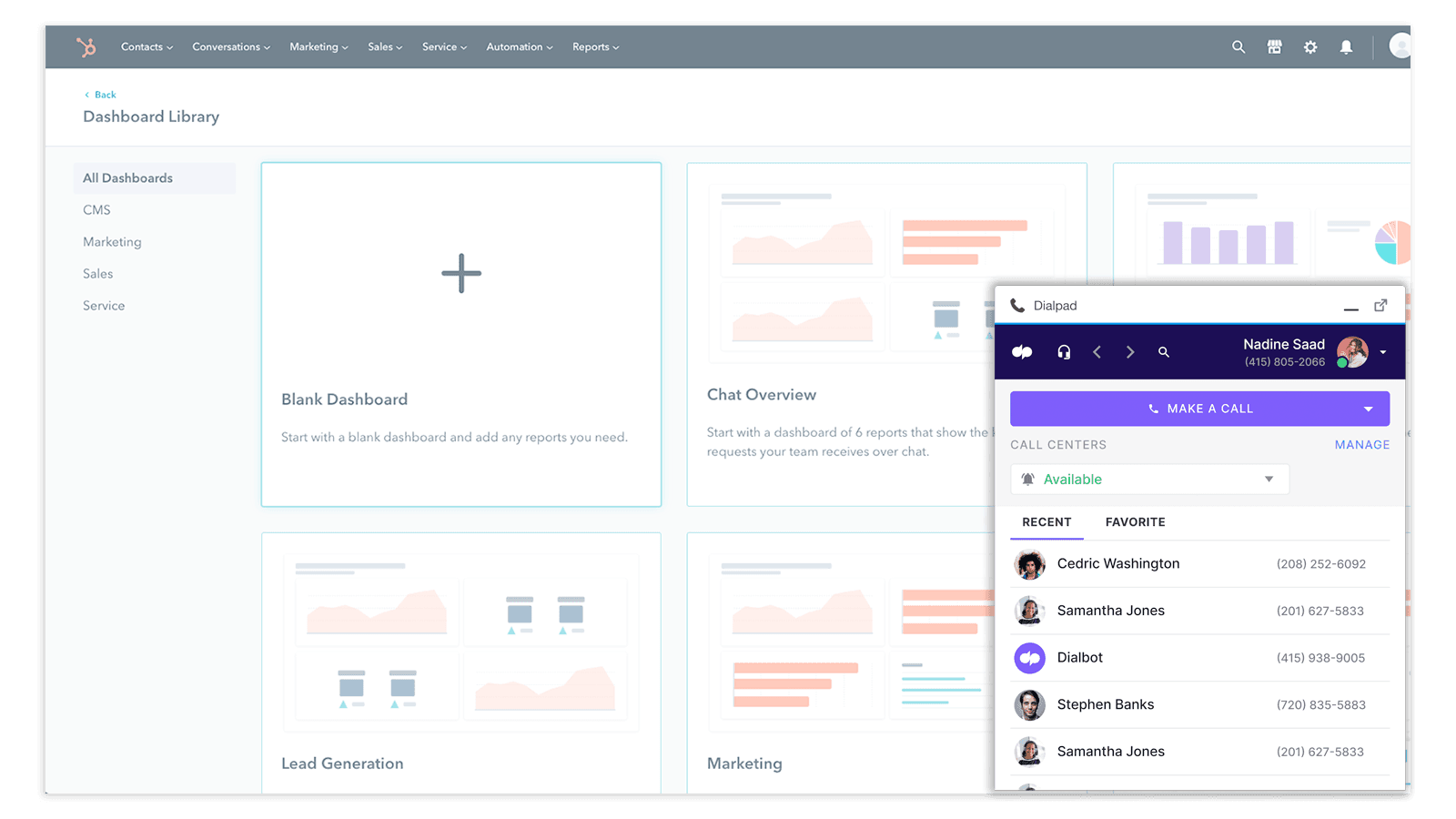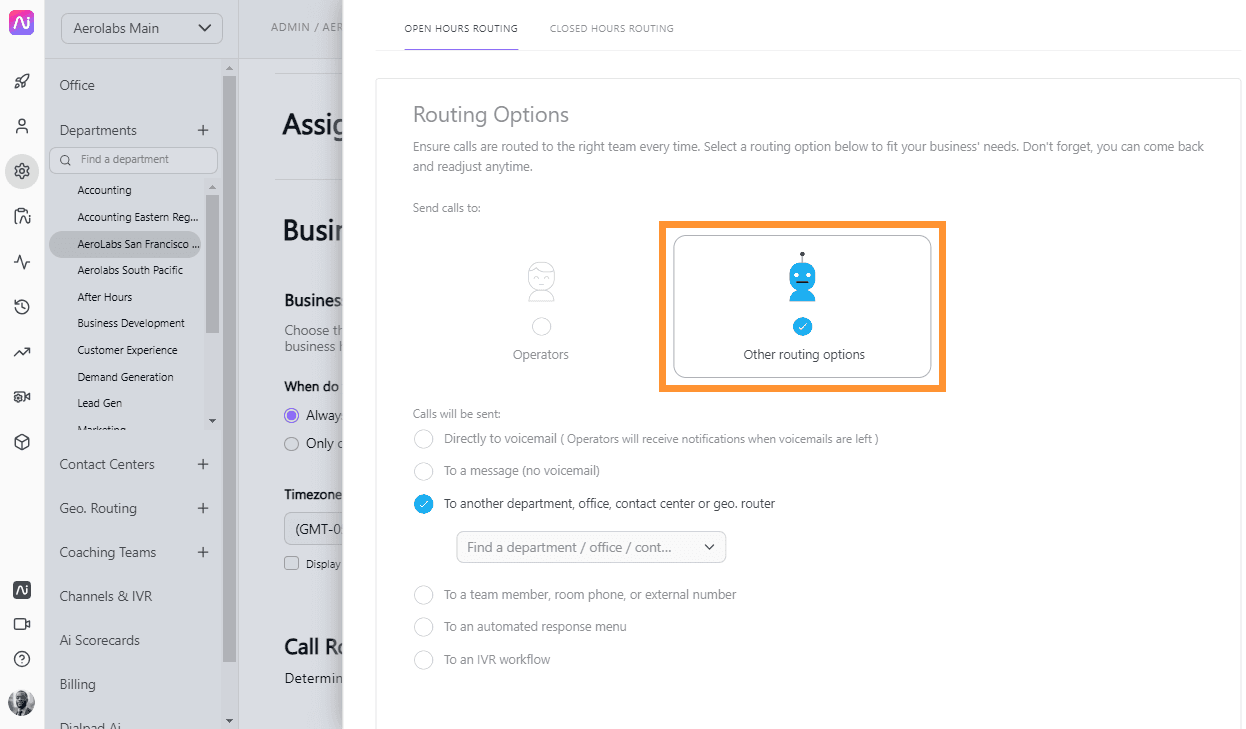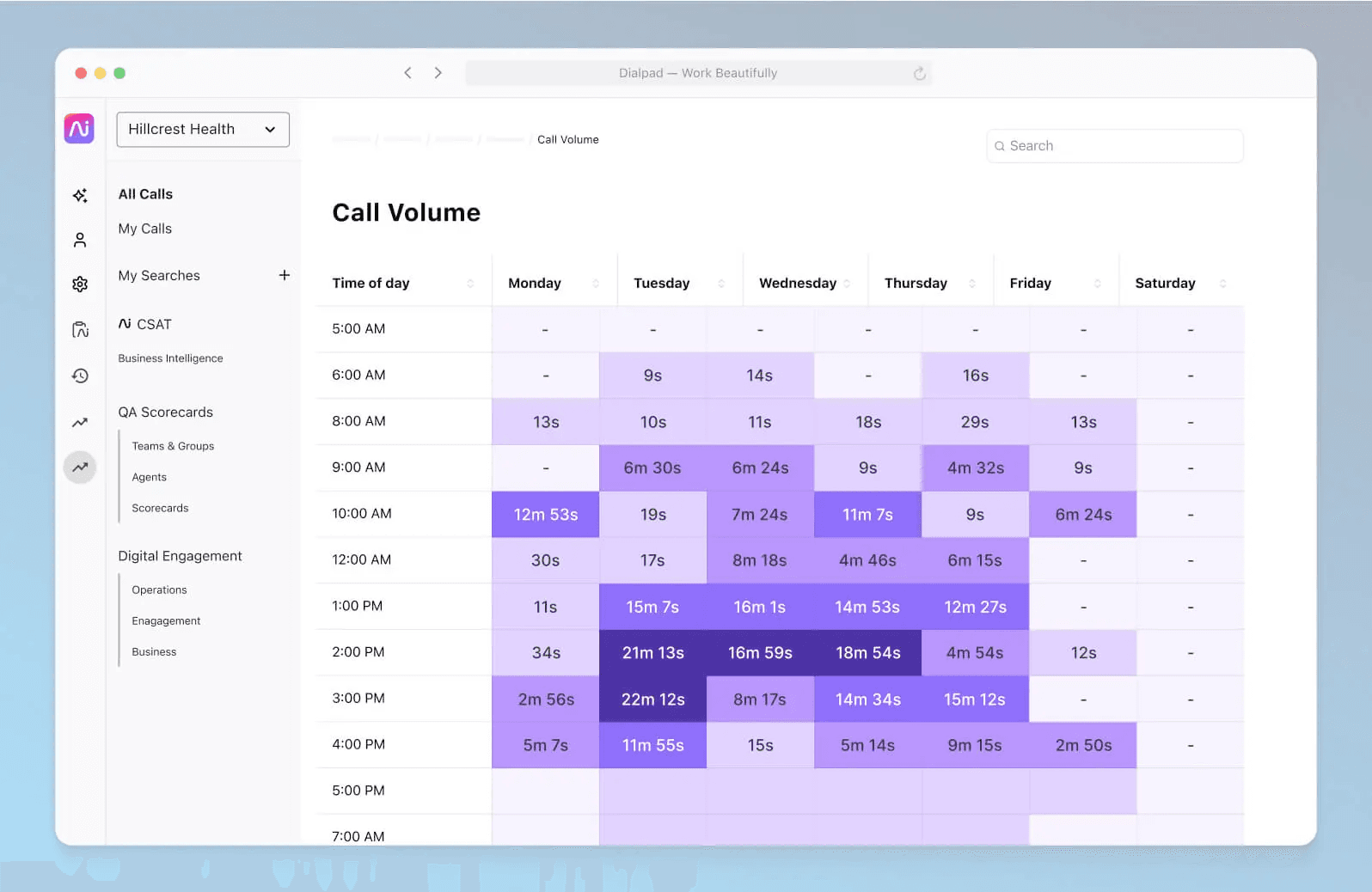
Tags
Share
No matter what size or industry your business is in, making sure that customers can reach someone quickly when they call you is crucial to maintaining a competitive edge and retaining clients.
One effective way to achieve this is by implementing call groups in your business phone system.
Keep reading to learn about what call groups are, their benefits, how to set them up, best practices, and a quick introduction to some top call group providers.
What is a call group?
A call group, sometimes also known as a ring group, is a feature in a business phone system that routes incoming calls to a specific group of phone lines or extensions based on predefined rules (typically, your front-line contact center agents). This ensures that calls are directed to the appropriate department quickly, which increases response efficiency—and keeps your customers happy.
Top five benefits of call groups
Implementing call groups offers several advantages like:
Increased customer service efficiency
By automatically directing calls to an available agent who’s best suited to deal with it, call groups reduce wait times and ensure your customers get the answers or help they need quickly.
Improved team collaboration
Call groups can also improve team collaboration by making it easier for team members to help each other, transfer calls more efficiently, and work together to resolve customer inquiries faster.
Optimized call distribution
With predefined routing rules, call groups distribute incoming calls evenly among team members, preventing overload on specific individuals and ensuring a balanced workload.
Higher cost-effectiveness
Call groups help automate the call handling process, which means you don’t need someone just to manage the phones and manually route calls, which leads to cost savings in the long run.
Enhanced brand image and reputation
A well-organized call routing system helps you project a more professional image to customers by helping your agents make sure calls are answered promptly and professionally, which builds a reliable and customer-focused reputation for your brand.
How do call groups work?
Call groups operate by routing incoming calls to multiple agents or extensions based on predefined rules. When your business gets a call, the system follows the parameters you’ve set to determine which group or individual should handle the call.
Configuration options for call groups
There are different ways you can configure call groups. For example:
Ring groups: All phones in the group ring simultaneously when a call is received, and the first to answer handles the call.
Hunt groups: Calls are directed to a list of numbers in a specific sequence, “hunting” for an available agent until someone answers.
Broadcast groups: Similar to ring groups, but all phones ring simultaneously, and multiple agents can join the call if needed.
Sequential ringing: Calls ring one phone at a time in a predetermined order until someone answers.
Circular/round-robin call ringing: Calls are distributed evenly among team members in a rotating order.
Uniform call distribution: Calls are directed to the agent who has been idle the longest.
Simultaneous call distribution: All phones in the group ring at the same time, and the first agent to answer handles the call.
Use cases of call groups
Call groups are pretty versatile and can be used in many scenarios. These are the most common ones:
Customer service: Ensuring customer inquiries are directed to the appropriate support team.
Sales: Routing potential clients to available sales reps.
Technical support: Directing technical issues to specialized support staff.
How to set up a call group in four steps
Implementing a call group involves the following steps:
1. Choose the right system
Selecting a good communications platform or phone system with a well-designed call group feature is essential. Here are some key factors to consider:
Customizable call routing allows you to define specific call paths that align with their workflow and customer service needs.
Scalability ensures that the system can grow alongside your business without requiring frequent upgrades or replacements.
Integrations with your existing tech stack such as CRM software, helpdesk platforms, and other business applications. For example, Dialpad integrates with popular business tools like Salesforce and HubSpot:

Advanced analytics and reporting provide valuable insights into call metrics, helping businesses optimize call handling and agent performance.
A user-friendly interface makes it easy for administrators and agents to manage calls, reducing training time and improving efficiency.
Mobility and remote access features allow employees to handle calls from anywhere, supporting hybrid and remote work environments.
Voicemail and call recording functionalities help businesses capture missed calls and maintain quality assurance by reviewing past conversations.
Real-time monitoring enables managers to track call activities live, ensuring optimal call distribution and quick issue resolution. Dialpad’s AI-powered sentiment analysis feature helps supervisors quickly spot if a customer call is going badly, and jump in if needed:

Scheduling and availability management tools help businesses organize agent work hours and ensure adequate call coverage at all times.
Security and compliance measures protect sensitive data and ensure adherence to industry regulations and privacy standards.
Multilingual support accommodates businesses serving diverse customer bases, ensuring a smooth communication experience for all callers.
Cost efficiency ensures that the system provides high-quality service without exceeding budget constraints.
2. Determine your agent groups
Organize staff into groups based on factors such as department, skill set, or location to ensure calls are directed to the most appropriate team.
3. Set call distribution rules
Define how calls will be distributed within each group, choosing from ring patterns like sequential, round-robin, or simultaneous ring.
4. Set call queue rules
Establish protocols for handling calls when all agents are busy, such as placing callers in a queue, offering voicemail options, or providing estimated wait times. For example, here’s how it looks in Dialpad:

Five factors to consider before implementing call groups
Before setting up call groups, here are a few things to consider:
Matching agent or employee skills to assigned call groups: Ensure agents have the right skills to handle specific call types.
Reliable VoIP technology and infrastructure: Invest in a phone system or unified communications platform that uses reliable VoIP technology and infrastructure to support your call groups effectively. Dialpad, for example, runs on a global voice network that gives you enterprise-grade call quality almost anywhere in the world.
Availability of number of calls and agents: Make sure you’re aligning your scheduling with the number of incoming calls so that you’re not under or over-staffed.
Privacy and security: Does your communications platform have built-in security measures to protect sensitive information during calls?
Best practices for managing call groups
Here are three best practices for managing call groups effectively:
1. Monitor performance regularly
Consistently tracking call group performance helps you ensure calls are distributed efficiently and customer inquiries are always handled promptly. Use call analytics and reporting tools to measure key metrics like average response time, call abandonment rate, and agent workload. Platforms like Dialpad even come with built-in heatmaps to show you if there are any spikes in call volumes:

2. Give agents ongoing training and support
Provide continuous training to help your agents stay updated on best practices for using call groups effectively. This includes educating them on call routing rules, customer service techniques, and troubleshooting common issues. You could also offer other forms of support, such as refresher courses and access to knowledge bases, AI-powered tools that reduce low-value or repetitive tasks, and so on.
3. Continuously optimize call distribution strategies
Choosing the right call distribution method—whether that’s sequential, round-robin, or simultaneous ringing—ensures that calls reach the right agent quickly. Regularly assess your team’s workload, skills, and availability, and adjust your call routing settings as needed.
Top five call providers in 2025
Selecting the right call group provider is crucial for businesses wanting to enhance their customer experience and operational efficiency. Here's an overview of five good call group providers:
1. Dialpad Connect
Dialpad Connect is an AI-powered communication platform that offers advanced call groups, call routing, seamless integrations, and a user-friendly interface. With its proprietary AI and LLM, DialpadGPT, Dialpad also provides advanced features like sentiment analysis and actionable insights to help you improve your customer interactions.
Key features:
Customizable call routing to optimize efficiency
Native integrations with CRM and business tools like Salesforce and HubSpot
Built-in analytics to track call performance and agent productivity
Mobile-friendly platform for remote and hybrid teams
Pros:
AI-powered conversational insights and sentiment analysis
Fully unified communications platform with voice calling, video meetings, and SMS/MMS + team messaging included on the base plan
Easy-to-use interface with minimal setup
Scalable for businesses of all sizes
Cons:
Some advanced features require higher-tier plans
Standard Plan: Starts at $15 per user per month
Pro Plan: Starts at $25 per user per month
Enterprise Plan: Custom pricing available
2. RingCentral RingEXTM
RingCentral is a legacy business phone system and unified communications platform, and its RingEX Business Phone product comes with call management features, voice calling, video meetings, and integrations with business tools like Microsoft Teams and Google Workspace.
Key features:
Unified communications with voice, video, and messaging
3 departments / ring groups included with the base plan
Customizable call routing
Over 300+ integrations with popular software
Pros:
Like Dialpad, provides multiple communication channels in one app1
Also has an events product for webinars and other large-scale virtual events
Like Dialpad, comes with unlimited domestic calling in the base plan
Cons:
Base plan is more expensive compared to Dialpad Connect
Has only basic call queues in the least expensive plan1
Pricing1:
Core Plan: Starts at $20 per user per month (regular price)
Advanced Plan: Starts at $25 per user per month (regular price)
Ultra Plan: Starts at $35 per user per month (regular price)
3. RingOver
RingOver is a cloud-based VoIP phone system that’s unique in that it comes with unlimited international calling to over 110 destinations, along with other business phone system basics like call forwarding, video meetings, and messaging.
Key features:
Unlimited international calls
Call forwarding
Call recording
Pros:
Good for global businesses that need to make lots of international calls
Base plan comes with call transcription and call summary
Has a mobile and desktop application
Cons:
Base plan does not include call groups2
Base plan does not include call queues2
Pricing2:
Smart Plan: Starts at $21 per user per month (regular price)
Business Plan: Starts at $44 per user per month (regular price)
Advanced Plan: Reach out for a quote
4. 8x8 Work®
8x8 is a unified communications platform similar to Dialpad Connect and RingCentral RingEX that’s designed for businesses that need to communicate with customers through different channels.
Key features:
Calling, meeting, and messaging in one app
Global coverage
A “receptionist console”3
Pros:
Can help streamline communications into one platform
Global coverage for businesses with an international customer base
Cons:
No information about pricing on its website—you have to reach out for a quote
No information on the pricing page about what call groups features are included and how much they cost3
Pricing:
Reach out for a quote
5. Ooma Office
Ooma is a basic VoIP phone system designed for small businesses and startups. While it’s less robust than some of the other options on this list, it does offer basic call management features, voicemail transcription, and call forwarding.
Key features:
Unlimited calling to the US, Canada, Mexico, and Puerto Rico
Voicemail transcription and video conferencing available (on higher tier plans)4
Pros:
Comes with different communication channels
Ring groups and virtual receptionist features are free with the base plan4
Cons:
Limited advanced features for scaling businesses
Fewer integrations with third-party tools
Pricing4:
Ooma Office Essentials: Starts at $19.95 per user per month
Ooma Office Pro: Starts at $24.95 per user per month
Ooma Office Pro Plus: Starts at $29.95 per user per month
Set up call groups in minutes with Dialpad
Implementing a call group system is one of the most effective ways to enhance customer service, streamline communication, and ensure that no call goes unanswered. Whether you’re a small business looking for affordability or a large enterprise needing customizable routing, choosing the right provider can make all the difference.
Dialpad offers not only easily customizable call groups features, but also unique proprietary AI-powered functionality like real-time transcriptions, recaps, keyword tracking, sentiment analysis, and more.
By investing in a reliable and scalable call group system, you can improve your team’s efficiency, boost customer satisfaction, and stay ahead of the competition. Why not give Dialpad a try for free?
1ringcentral.com/office/plansandpricing.html
2ringover.com/pricing#block_features
38x8.com/products/plans-and-pricing
4ooma.com/small-business-phone-systems/plans/
Try Dialpad for free now
Sign up for a free 14-day trial, or book a product tour with our team!

